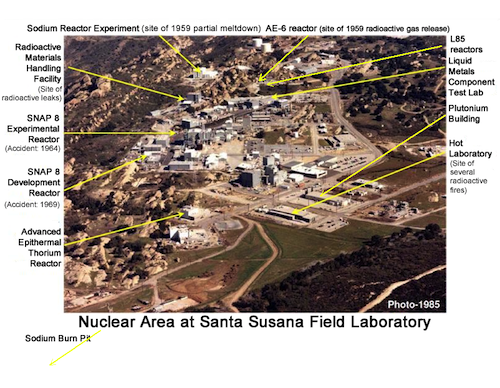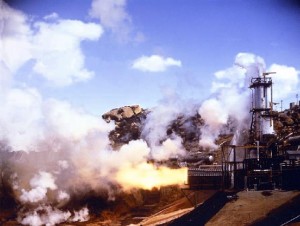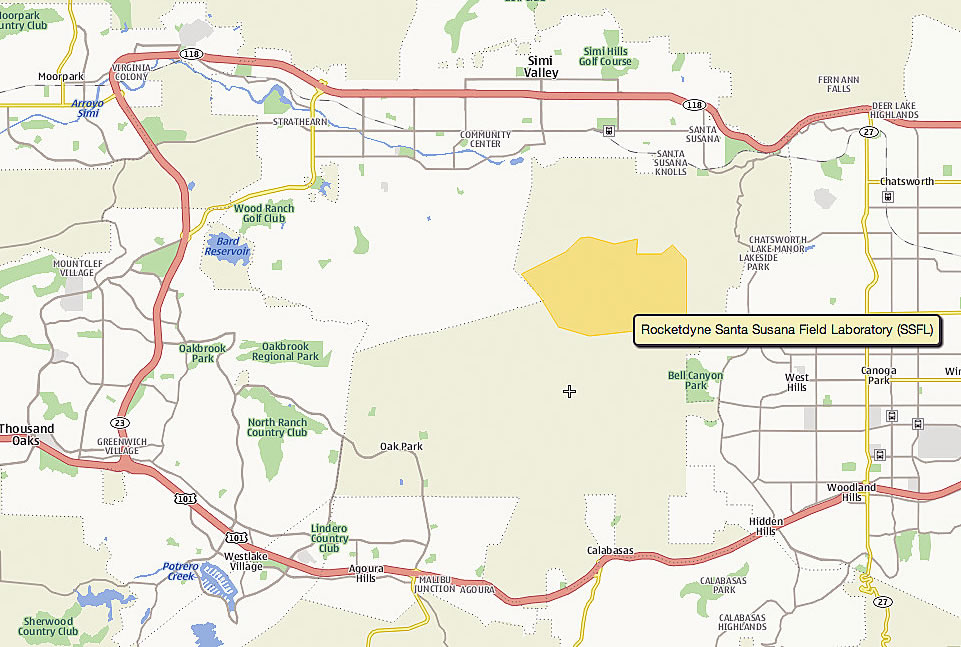 The Santa Susana Field Laboratory (SSFL), also known as Rocketdyne, is a former nuclear and rocket engine testing facility that is contaminated with radiological and chemical pollutants. The 2,850 acre site is near Simi Valley, Chatsworth, Canoga Park, Woodland Hills, West Hills, Westlake Village, Agoura Hills, Oak Park, Calabasas, and Thousand Oaks.
The Santa Susana Field Laboratory (SSFL), also known as Rocketdyne, is a former nuclear and rocket engine testing facility that is contaminated with radiological and chemical pollutants. The 2,850 acre site is near Simi Valley, Chatsworth, Canoga Park, Woodland Hills, West Hills, Westlake Village, Agoura Hills, Oak Park, Calabasas, and Thousand Oaks.
SSFL was established in the late 1940s by the Atomic Energy Commission as a testing facility (a “field laboratory”) for nuclear reactor development work too dangerous to perform close to a populated area. Over the following decades, however, the population mushroomed around the area. Currently, over half a million people reside within ten miles of the site.
The site was home to ten nuclear reactors, half a dozen critical facilities, a plutonium fuel fabrication facility, and a “hot lab” for decladding and disassembling irradiated nuclear fuel shipped in from around the Atomic Energy Commission/Department of Energy (DOE) national nuclear complex as an initial step for reprocessing. Numerous accidents, releases, and spills resulted. In 1959, the SRE reactor experienced a partial meltdown, in which a third of the fuel experienced melting. In 1964, a SNAP reactor suffered damage to 80% of its fuel. In 1968-9 another reactor suffered similar fuel damage. There were numerous nuclear fires in and at the Hot Lab. For decades, radioactively and chemically contaminated reactor components covered with sodium were reacted in open pits (the sodium “burn pit”) with airborne releases of contaminants as well as surface runoff of the contaminants offsite. Today, the site remains contaminated with dangerous radionuclides such as cesium-137, strontium-90, and plutonium-239.
In addition, tens of thousands of rocket tests were conducted at SSFL, resulting in significant chemical contamination. Hundreds of thousands of gallons of trichloroethylene (TCE) were used to flush out rocket test engines and then allowed to seep into the soil and groundwater. The site is also contaminated with perchlorate, dioxins, heavy metals, and volatile and semi-volatile organic compounds that can cause harm to human health.
Contamination from SSFL has not stayed on site. Perchlorate, a component of solid rocket fuels that disrupts human development and which contaminates much of SSFL, has been found to have migrated offsite and contaminates roughly a third of wells in Simi Valley monitored for it. TCE, a carcinogen, has also migrated offsite. Annual monitoring reports for surface water contamination show rain carrying off toxic materials offsite, at levels exceeding health-based benchmarks and other limits, hundreds of times in recent years.
A study by the UCLA School of Public Health found elevated cancer death rates among both the nuclear and rocket workers from exposures to these toxic materials. Another study by UCLA found that the rocket testing had led to offsite exposures to hazardous chemicals by the neighboring population at levels exceeding EPA standards. A study performed for the federal Agency for Toxic Substances and Disease Registry found elevated cancer rates in the offsite population associated with proximity to SSFL.
In 2010, the agency responsible for overseeing the cleanup, the California Department of Toxic Substances Control (DTSC), signed clean up agreements (AOCs) with NASA and the Department of Energy (DOE) to cleanup their portions of the site to background levels of contamination – meaning where they find contamination, they will clean it up. The Boeing Company, which owns the largest portion of the site, has not signed such an agreement and is proposing much lower cleanup standards.


